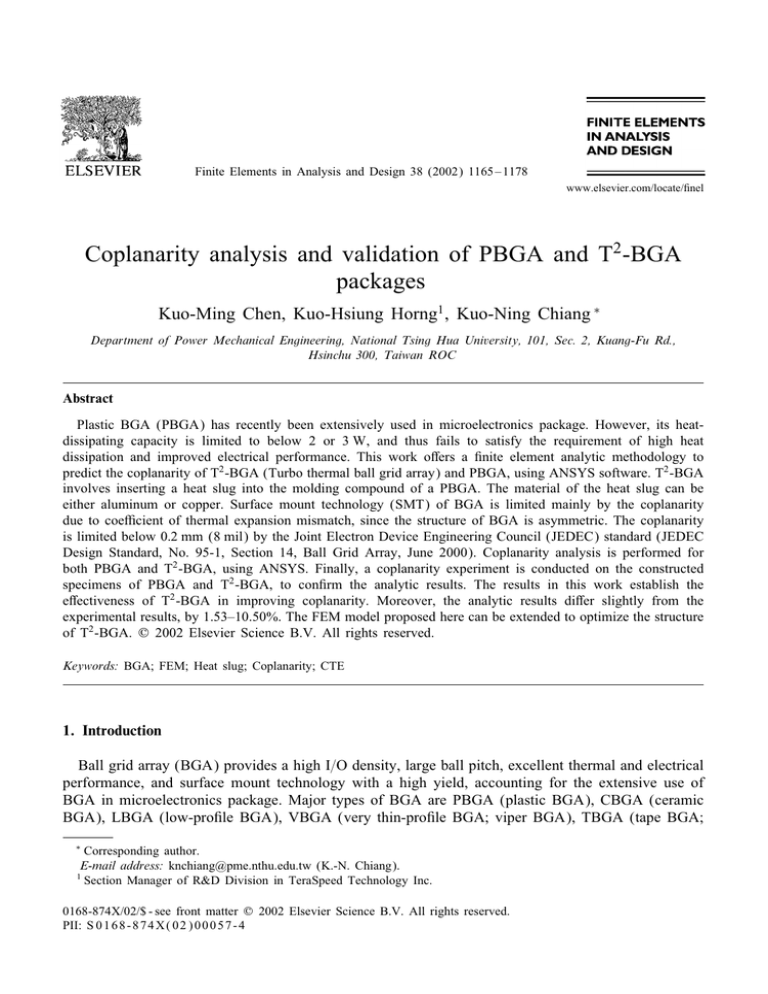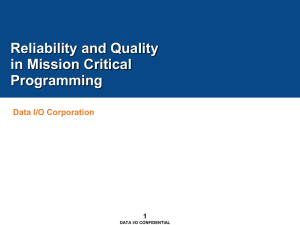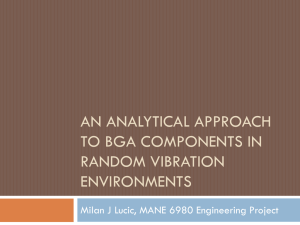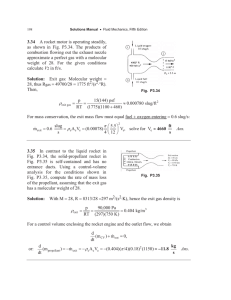
Finite Elements in Analysis and Design 38 (2002) 1165 – 1178
www.elsevier.com/locate/"nel
Coplanarity analysis and validation of PBGA and T2-BGA
packages
Kuo-Ming Chen, Kuo-Hsiung Horng1 , Kuo-Ning Chiang ∗
Department of Power Mechanical Engineering, National Tsing Hua University, 101, Sec. 2, Kuang-Fu Rd.,
Hsinchu 300, Taiwan ROC
Abstract
Plastic BGA (PBGA) has recently been extensively used in microelectronics package. However, its heatdissipating capacity is limited to below 2 or 3 W, and thus fails to satisfy the requirement of high heat
dissipation and improved electrical performance. This work o7ers a "nite element analytic methodology to
predict the coplanarity of T2 -BGA (Turbo thermal ball grid array) and PBGA, using ANSYS software. T2 -BGA
involves inserting a heat slug into the molding compound of a PBGA. The material of the heat slug can be
either aluminum or copper. Surface mount technology (SMT) of BGA is limited mainly by the coplanarity
due to coe:cient of thermal expansion mismatch, since the structure of BGA is asymmetric. The coplanarity
is limited below 0:2 mm (8 mil) by the Joint Electron Device Engineering Council (JEDEC) standard (JEDEC
Design Standard, No. 95-1, Section 14, Ball Grid Array, June 2000). Coplanarity analysis is performed for
both PBGA and T2 -BGA, using ANSYS. Finally, a coplanarity experiment is conducted on the constructed
specimens of PBGA and T2 -BGA, to con"rm the analytic results. The results in this work establish the
e7ectiveness of T2 -BGA in improving coplanarity. Moreover, the analytic results di7er slightly from the
experimental results, by 1.53–10.50%. The FEM model proposed here can be extended to optimize the structure
of T2 -BGA. ? 2002 Elsevier Science B.V. All rights reserved.
Keywords: BGA; FEM; Heat slug; Coplanarity; CTE
1. Introduction
Ball grid array (BGA) provides a high I=O density, large ball pitch, excellent thermal and electrical
performance, and surface mount technology with a high yield, accounting for the extensive use of
BGA in microelectronics package. Major types of BGA are PBGA (plastic BGA), CBGA (ceramic
BGA), LBGA (low-pro"le BGA), VBGA (very thin-pro"le BGA; viper BGA), TBGA (tape BGA;
∗
Corresponding author.
E-mail address: knchiang@pme.nthu.edu.tw (K.-N. Chiang).
1
Section Manager of R&D Division in TeraSpeed Technology Inc.
0168-874X/02/$ - see front matter ? 2002 Elsevier Science B.V. All rights reserved.
PII: S 0 1 6 8 - 8 7 4 X ( 0 2 ) 0 0 0 5 7 - 4
1166
K.-M. Chen et al. / Finite Elements in Analysis and Design 38 (2002) 1165 – 1178
Fig. 1. Coplanarity of BGA package.
thin-pro"le BGA), and super BGA. PBGA belongs to the cavity-up type, the type which is the
cheapest and most prevalent. However, PBGA does not meet the standards of high heat dissipation
and improved electrical performance. SBGA, VBGA and TBGA, although exhibit a satisfactory thermal performance, are of the cavity-down type, and are thus incompatible with, and more expensive
than, PBGA.
T2 -BGA has a superior thermal and electrical performance than PBGA, and is compatible with
PBGA with respect to process, structure, material, and equipment required for production. T2 -BGA
involves inserting a heat slug into the molding compound of a PBGA. The heat slug can be either
buried in, or exposed to, a molding compound. T2 -BGA has been patented in the United States (Patent
No. US5851337, US5982621), Japan (Patent No. JP3051914) and Taiwan (Patent No. 168029M).
Experimental results indicate that T2 -BGA enhances thermal performance by 27% over that of PBGA
[2], and reduces self-inductance by 10 –25% [3] (for a two-layered substrate). As is well known,
BGA has an asymmetrical structure. Fig. 1 depicts the coplanarity of BGA package. T2 -BGA is
more complex than PBGA since a heat slug must be inserted into the molding compound. Poor
coplanarity may cause an open circuit after the surface mount technology (SMT) process. Liang
[4] and Mertol [5] found that substrate warpage is the primary cause of poor coplanarity. More
thickness, a higher Tg , and greater Young’s modulus of the substrate, and a thinner encapsulant
reduce warpage or coplanarity. Rao et al. [6] investigated the e7ect of substrate warpage on the
second level assembly of advanced PBGA. Kousaka et al. [7] presented the inPuence of material
combination on the warpage PBGA. Yang et al. [8] addressed the possibility of changing package
geometry by adding rib structures to reduce thermal warpage during the rePow. Assembly houses
usually set the coplanarity speci"cation below 150 m (6 mil) (see also Ref. [1]).
2. The structure of T2 -BGA
Figs. 2, 3 and 4 display the cross-sections of PBGA, T2 -BGA with a buried heat slug, and T2 -BGA
with an exposed heat slug, respectively. Fig. 5 outlines the BGA process, indicating that the T2 -BGA
process is exactly the same as the PBGA process, except for the dropping of a heat slug into the
molding compound.
Mold Compound
Substrate
Chip
Thermal Via
Signal Via
Thermal Ball
Fig. 2. Cross-section of PBGA.
K.-M. Chen et al. / Finite Elements in Analysis and Design 38 (2002) 1165 – 1178
Mold Compound
Substrate
Heat Slug
Thermal Via
1167
Signal Via
Thermal Ball
Fig. 3. Cross-section of T2 -BGA (with a buried heat slug).
Mold Compound
Substrate
Heat Slug
Thermal Via
Signal Via
Thermal Ball
Fig. 4. Cross-section of T2 -BGA (with an exposed heat slug).
Wafer Mount
Molding
Die Saw
Marking
Die Bond
Post Mold Cure
Plasma Clean
Ball Attach
Wire Bond
IR Reflow
Post Bond Inspection
Flux Clean
Heat Slug Attach
Sigulation
Plasma Cleaan
Finish
Fig. 5. T2 -BGA processes.
3. Coplanarity
3.1. Coplanar simulation
This work simulates the coplanarity of "ve types of PBGA and T2 -BGA, using ANSYS software.
The equilibrium equation is
([Ke ] + [Kef ]){u} − {Feth } = [Me ]{u}
S + {Fepr } + {Fend };
(1)
1168
K.-M. Chen et al. / Finite Elements in Analysis and Design 38 (2002) 1165 – 1178
Table 1
Packaging list and speci"cation
Items=Types
PBGA
T2 -BGA
(Exposed Cu)
T2 -BGA
(Exposed Al)
T2 -BGA
(Buried Cu)
T2 -BGA
(Buried Al)
Packaging Size
Die size
Die thickness
Substrate thickness
Substrate layer
Molding compound thickness
Total solder ball #
Thermal ball #
Solder ball height
Solder ball pitch
Heat slug material
Heat slug height
Heat slug thickness
35 × 35 mm
10 × 10 mm
0:3 mm
0:56 mm
2L
1:17 mm
456
6×6
0:6 mm
1:27 mm
None
None
None
35 × 35 mm
10 × 10 mm
0:3 mm
0:56 mm
2L
1:17 mm
456
6×6
0:6 mm
1:27 mm
Copper
1:17 mm
0:3 mm
35 × 35 mm
10 × 10 mm
0:3 mm
0:56 mm
2L
1:17 mm
456
6×6
0:6 mm
1:27 mm
Aluminum
1:17 mm
0:3 mm
35 × 35 mm
10 × 10 mm
0:3 mm
0:56 mm
2L
1:17 mm
456
6×6
0:6 mm
1:27 mm
Copper
1:0 mm
0:2 mm
35 × 35 mm
10 × 10 mm
0:3 mm
0:56 mm
2L
1:17 mm
456
6×6
0:6 mm
1:27 mm
Aluminum
1:0 mm
0:2 mm
where [Ke ] is the element sti7ness matrix; [Kef ] is the element foundation sti7ness matrix; {u} is
the nodal displacement vector; {Feth } is the element thermal load vector; [Me ] is the element mass
matrix, {u}
S is the acceleration vector, {Fepr } is the element pressure vector, and {Fend } is the nodal
force applied to the element. {u},
S {Fepr } and {Fend } are equal to zero in the coplanar problem of
package. Eq. (1) yields the expression
([Ke ] + [Kef ]){u} − {Feth } = 0:
(2)
Substituting {u} into Eqs. (3) and (4), yields the strain and stress
{} = [B]{u};
(3)
{} = [D]{e };
{} = {e } + {th };
{th } = (T − Tref )[x y z ]T ;
(4)
where {} is the total strain vector = [x y z xy yz xz ]T ; [B] is the strain-displacement matrix
which is based on the element shape functions; {} is the stress vector = [x y z xy yz xz ]T ,
[D] is the elastic sti7ness matrix, {e } is the elastic strain vector; {th } is the thermal strain vector;
x , y , z are the coe:cients of thermal expansions in the x, y, and z directions, T is the current
◦
temperature, and Tref is the reference (strain or stress free) temperature which is set at 175 C.
An element of Solid 45 type is used to construct the "nite element model. Only a quarter of
the "nite element meshes need to be constructed, since the BGA possesses quartered symmetry.
Table 1 speci"es T2 -BGA and PBGA package. Table 2, and Figs. 6(a) and (b) give the material
properties of the specimen of bismaleimide triazine (BT) resin with non-linear properties. Fig. 7
depicts the structure and the material thickness of BGA. Figs. 8(a) – (d) show the "nite element
K.-M. Chen et al. / Finite Elements in Analysis and Design 38 (2002) 1165 – 1178
1169
Table 2
Material properties
◦
Items
E (GPa)
(ppm= C)
Thickness
Si (Die)
Molding compound
Die adhesive epoxy
Solder mask
Copper trace on substrate
BT resin
Copper heat slug
Al heat slug
131
14.21
1.405
2.4108
82.7
See Fig. 6(a)
115.1
69
2.8
◦
13=47 (Tg = 200 C)
◦
45=228 (Tg = 32 C)
19
17
X 14 Y 14 Z 51
17.7
22
0.3
0.3
0.21
0.467
0.35
See Fig. 6(b)
0.33
0.33
0:3 mm
1:2 mm
0:05 mm
50 m
30 m
0:4 mm
0:2=0:3 mm
0:2=0:3 mm
30
Young's modulus (GPa)
25
20
15
10
5
0
0
50
100
150
200
250
Temperature (Degree C)
(a)
0.25
Poisson's ratio
0.2
0.15
0.1
0.05
0
0
(b)
50
100
150
200
250
Temperature (Degree C)
Fig. 6. (a) Young’s modulus vs. temperature of BT resin; and (b) Poisson’s ratio vs. temperature of BT resin.
1170
K.-M. Chen et al. / Finite Elements in Analysis and Design 38 (2002) 1165 – 1178
Fig. 7. Structure and material thickness of BGA: (a) PBGA FEM model; (b) PBGA (no die) FEM model;
(c) T2 -BGA (with a buried heat slug) FEM model; and (d) T2 -BGA (with an exposed heat slug) FEM model.
Fig. 8. BGA packages FEM models.
K.-M. Chen et al. / Finite Elements in Analysis and Design 38 (2002) 1165 – 1178
1171
Expansion
Tg
Temperature
Fig. 9. Normal CTE diagram of die adhesive epoxy.
models of PBGA and T2 -BGA. In these "nite element models, Fig. 8(a) includes 3288 elements and
4303 nodes (12562 DOF); Fig. 8(b) includes 2051 elements and 2787 nodes (8102 DOF); Fig. 8(c)
includes 13950 elements and 16427 nodes (48349 DOF), and Fig. 8(d) includes 8865 elements and
10 883 nodes (32058 DOF). Eqs. (2) – (4) and the following boundary condition can be applied to
solve the coplanarity of the package.
The origin of the Cartesian coordinate system is de"ned at the center of the bottom of the substrate,
and its displacement is "xed at zero. The y direction is constrained, but the x and z directions can
move freely in the xz plane. Furthermore, the x direction is constrained, but the y and z directions
can freely move in the yz plane.
◦
◦
Thermal loading is set to cool from 175 C to 25 C. The stress-free condition is assumed to be
◦
◦
◦
held at 175 C, which is the molding temperature. When the thermal load cools from 175 C to 25 C,
◦
it passes through the glass transition temperature (Tg ) of die adhesive epoxy, which is 32 C. This
work divides the analytic procedure into two steps to solve a thermal problem. The "rst step of the
◦
◦
◦
◦
thermal loading is from 175 C to 32 C; the second step is from 32 C to 25 C. This work establishes
an equivalent CTE (equ ) method to simplify the "nite element analysis procedure. Fig. 9 presents
the normal CTE diagram of die adhesive epoxy, and Fig. 10 shows the CTE diagram of die adhesive
epoxy, after transferring the vertical coordinate from expansion to CTE.
The equivalent CTE can be calculated from
equ =
2 (Th − Tg ) + 1 (Tg − Tl )
Th − T l
(5)
where equ is the equivalent CTE; Tg is the glass transition temperature, 1 is the "rst coe:cient
of thermal expansion when the temperature is below Tg ; 2 is the second coe:cient of thermal
1172
K.-M. Chen et al. / Finite Elements in Analysis and Design 38 (2002) 1165 – 1178
α2
CTE
α1
T1
Tg
Temperature
Th
Fig. 10. CTE diagram of die adhesive epoxy after transferring the vertical coordinate: (a) PBGA simulation results; (b)
PBGA (no die) simulation results; (c) T2 -BGA (with a buried Al heat slug) simulation results; (d) T2 -BGA (with a
buried Cu heat slug) simulation results; (e) T2 -BGA (with an exposed Al heat slug) simulation results; and (f) T2 -BGA
(with an exposed Cu heat slug) simulated results.
expansion when the temperature exceeds Tg ; Th represents the high reference temperature, and Tl is
the low reference temperature.
◦
Substituting the die adhesive epoxy data into Eq. (5) yields a CTE equivalent to 219:46 ppm= C.
Only one step is required to analyze coplanarity after the equivalent CTE is obtained. Fig. 11 shows
the analytic coplanarity of each package. Fig. 12 shows the maximum coplanarity.
The result reveals that T2 -BGA with an exposed copper heat slug exhibited the best coplanarity,
followed by PBGA and then T2 -BGA with a buried aluminum heat slug. PBGA and T2 -BGA with a
buried aluminum heat slug closely resemble each other. The worst case is T2 -BGA with an exposed
aluminum heat slug, since the CTE of aluminum markedly di7ers from that of the molding compound
and substrate. The maximum warpage occurs at the corner of each BGA package type, as shown in
Fig. 11; all the packages are convex on the ball side.
4. Experiment
Figs. 13 and 14 are top views of PBGA and T2 -BGA specimens, and Fig. 15 illustrates the solder
ball distribution of BGA. Each package type has 24 specimens. The coplanarity of package can be
measured in two ways: (a) using shadow moirVe, and then applying an appropriate formula to "nd
the coplanarity, and (b) directly measuring the coplanarity using a laser vision system [9,10]. The
latter is used here to measure the coplanarity, and the laser vision instrument is an 800-20 scanning
laser. The coplanarity measurement needs to determine a best-"t plane for the package. The position
of the plane is obtained from sample height measurements taken from the substrate. The coplanarity
K.-M. Chen et al. / Finite Elements in Analysis and Design 38 (2002) 1165 – 1178
Fig. 11. Simulation results of coplanarity.
1173
1174
K.-M. Chen et al. / Finite Elements in Analysis and Design 38 (2002) 1165 – 1178
180
Coplanarrity (um)
150
120
90
60
30
0
PBGA
PBGA
(No Die)
T2-BGA
(Buried Al)
T2-BGA
(Buried Cu)
T2-BGA
(Exposed Al)
T2-BGA
(Exposed Cu)
Fig. 12. Simulation results of maximum coplanarity.
Fig. 13. PBGA diagram.
is the maximum distance from ball height to the plane. The coplanarity of BGA is calculated
by [10]
N
1 Cop =
(Hi − HW )2 ;
(6)
N − 1 i=1
where Cop is the coplanarity of the BGA package; N is the number of solder balls; Hi is the
height of the ith solder ball, and HW is the mean height of the balls. Twenty-four coplanarity values
were obtained for each type of package, and the measured coplanarity results include maximum,
K.-M. Chen et al. / Finite Elements in Analysis and Design 38 (2002) 1165 – 1178
1175
Fig. 14. T2 -BGA diagram.
Fig. 15. Solder ball distribution of BGA.
minimum, and average values for each type of package, according to the tolerances in material, size,
ball volume, and the package process for each specimen. The maximum warpage is at the corner
in each BGA package, and the top surfaces of all packages are concave. Fig. 16 summarizes the
measured coplanarity results.
5. Discussion
Fig. 17 compares the analytic and experimental results with respect to coplanarity, it also reveals
the following:
(1) The error between analytic and measurement results is between 1.53% and 10.50%, con"rming
that FEM in this work is highly accurate.
1176
K.-M. Chen et al. / Finite Elements in Analysis and Design 38 (2002) 1165 – 1178
180
Coplanarity (um)
150
120
90
60
30
PBGA
PBGA
(No Die)
T2-BGA
(Buried Al)
T2-BGA
(Exposed Al)
T2-BGA
(Exposed Cu)
Fig. 16. Coplanarity measurement results of BGA packages.
180
150
12.00%
Simulation
Expe riment
Error
10.50%
10.00%
8.89%
8.00%
90
6.00%
5.86%
60
Error
Coplanarity (um)
120
4.00%
2.92%
30
2.00%
1.53%
0
0.00%
PBGA
PBGA
(No Die)
T2-BGA
(Buried Al)
T2-BGA
(Exposed A l)
T2-BGA
(Exposed C u)
Fig. 17. Comparison between simulation and measurement results.
(2) Analytic and experimental results verify that all BGA packages are convex on the ball side, and
that the maximum coplanarity is at the corner of BGA package, since they have the greatest
DNP (distance to the neutral point) and exhibit the maximum strain and stress.
(3) From Figs. 12, 13 and 16, the magnitude of coplanarity, ordered from low to high, is PBGA
(without die), T2 -BGA (with an exposed copper heat slug), T2 -BGA (with a buried copper
K.-M. Chen et al. / Finite Elements in Analysis and Design 38 (2002) 1165 – 1178
1177
heat slug), PBGA, T2 -BGA (with a buried aluminum heat slug), and T2 -BGA (with an exposed
aluminum heat slug).
(4) According to Fig. 16, the coplanarity of PBGA ranges from 57.2 to 110 m (average is 84:8 m),
and that of PBGA without die is between 45 and 92:5 m (average is 66:5 m). Among the real
BGA packages (with die), T2 -BGA with an exposed copper heat slug shows the best coplanarity,
from 59.4 to 95 m (average is 74:2 m). The worst coplanarity is that of T2 -BGA with an
exposed aluminum heat slug, which ranges from 136.7 to 163:4 m (average is 150:9 m). The
coplanarity of T2 -BGA with a copper heat slug is better than that of T2 -BGA with an aluminum
◦
slug, because the coe:cient of thermal expansion of copper (17:6 ppm= C) is closer to that of
◦
◦
the substrate (14 ppm= C) and the molding compound (3=47 ppm= C) than that of aluminum
◦
(23 ppm= C).
6. Conclusion
This work presents a "nite element analytic methodology to predict the coplanarity of T2 -BGA and
PBGA using ANSYS software. T2 -BGA involves inserting a heat slug into the molding compound
of a PBGA; the heat slug can be either buried in, or exposed to, the molding compound. Inserting
the heat slug into a molding compound makes T2 -BGA more complex. Twenty-four specimens of
each type of package for coplanarity experiment are veri"ed for the analytic methodology accuracy.
A laser vision system is employed to determine the package coplanarity. The error between analytic
and measured results is from 1.53% to 10.50%, suggesting that the FEM model proposed here is
highly accurate. T2 -BGA with an exposed copper heat slug exhibits the best coplanarity. T2 -BGA
with an exposed aluminum heat slug has the worst coplanarity. The maximum coplanarity is at the
corner of each BGA package, and all the packages are convex on the ball side. The coplanarity of
T2 -BGA with a copper heat slug is better than that of T2 -BGA with an aluminum slug, because the
coe:cient of thermal expansion of copper is closer to that of both the substrate and the molding
compound than that of aluminum.
References
[1] JEDEC Design Standard, Design requirements for outlines of solid state and related products, JEDEC Standard No.
95-1, Section 14, ball grid array, June 2000.
[2] K.M. Chen, K.S. Horng, T2 -BGA thermal performance, Surf. Mount Technol. 27 (1999) 39–45.
[3] K.M. Chen, Novel package with thermally and electrically enhanced PBGA—T2 -BGA, Ind. Mater. 193 (1998)
163–168.
[4] D. Liang, Warpage study of glob top cavity-up EPBGA packages, in: Proceedings of the IEEE Electronics
Components Technology Conference, Orlando, FL, 1996, pp. 694 –701.
[5] A. Metrol, Application of the Taguchi method on the robust design of molded 225 plastic ball grid array packages,
IEEE Trans. Components Packag. Manuf. Technol.-Part B 18 (1995) 734–743.
[6] S.Y. Yang, S.C. Jiang, W.S. Lu, Ribbed package geometry for reducing thermal warpage and wire sweep during
PBGA encapsulation, IEEE Trans. Components Packag. Technol. 23 (4) (2000) 700–706.
[7] D.B. Rao, M. Prakash, E7ect of substrate warpage on the second level assembly of advanced plastic ball grid array
(PBGA) packages, 1997 IEEE=CPMT International Electronics Manufacturing Technology Symposium, Austin, TX,
1997, pp. 439 – 446.
1178
K.-M. Chen et al. / Finite Elements in Analysis and Design 38 (2002) 1165 – 1178
[8] T. Kousaka, N. Suzuki, M. Yasuda, InPuence of material combination on warpage and rePow crack resistance of
PBGA, 1998 IEEE=CPMT Electronics Packaging Technology Conference, Austin, TX, 1998, pp. 296 –301.
[9] K. Verma, D. Columbus, B. Han, Development of real time=variable sensitivity warpage measurement technique and
its application to plastic ball grid array package, IEEE Trans. Electron. Packag. Manuf. 22 (1) (1999) 63–70.
[10] P. Kim, S. Rhee, Three-dimensional inspection of ball grid array using laser vision system, IEEE Trans. Electron.
Packag. Manuf. 22 (2) (1999) 151–155.






